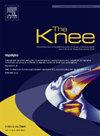Nitrided titanium alloy component enhances detection of small bone defects after total knee arthroplasty
IF 2
4区 医学
Q3 ORTHOPEDICS
引用次数: 0
Abstract
Background
This study compared the accuracy of various imaging modalities in detecting small bone defects simulating radiolucent lines (RLLs) around femoral components made of nitrided titanium alloy (Ti-6Al-4V) versus cobalt–chromium (Co–Cr) alloy.
Methods
Eight femoral components (four nitrided titanium alloy and four Co–Cr alloy) were implanted into pig femurs. Two total knee arthroplasty (TKA) models were fabricated for each component: normal and RLL TKA models. Fluoroscopically guided plain radiography, tomosynthesis, computed tomography (CT), and magnetic resonance imaging (MRI) were performed. Thirty orthopaedic surgeons independently assessed the images to determine the presence or absence of bone defects. Sensitivity, specificity, and accuracy were compared between materials and imaging modalities.
Results
The accuracy of detecting bone defects was significantly higher in nitrided titanium alloy components than in Co–Cr alloy components using fluoroscopically guided plain radiography (66.7 % vs. 53.3 %, P = 0.048), tomosynthesis (87.5 % vs. 63.3 %, P < 0.001), and CT (100 % vs. 61.7 %, P < 0.001). MRI showed no significant difference (52.5 % vs. 55.8 %, P = 0.698). Furthermore, for nitrided titanium alloy components, the accuracy of detecting bone defects around the femoral components using CT was 100 %.
Conclusions
Small bone defects simulating RLLs were more easily detected around nitrided titanium alloy femoral components than around Co–Cr alloy components. Nitrided titanium alloy femoral components may offer an advantage by enabling earlier detection of loosening and potentially reducing the need for complex revision surgery. These findings may serve as one of several factors for surgeons to consider when selecting implant materials for TKA.
氮化钛合金组件增强全膝关节置换术后小骨缺损的检测
本研究比较了氮化钛合金(Ti-6Al-4V)和钴铬(Co-Cr)合金制成的股骨假体周围模拟放射线(rll)的各种成像方式在检测小骨缺陷方面的准确性。方法将8个股骨假体(4个氮化钛合金和4个钴铬合金)植入猪股骨。每个部件制作两个全膝关节置换术模型:正常和RLL全膝关节置换术模型。进行了透视引导下的x线平片、断层合成、计算机断层扫描(CT)和磁共振成像(MRI)。30位骨科医生独立评估图像以确定是否存在骨缺损。比较不同材料和不同成像方式的敏感性、特异性和准确性。结果x线透视引导下氮化钛合金构件的骨缺损检出率(66.7% vs. 53.3%, P = 0.048)、断层合成(87.5% vs. 63.3%, P < 0.001)和CT (100% vs. 61.7%, P < 0.001)均显著高于钴铬合金构件。MRI显示差异无统计学意义(52.5% vs 55.8%, P = 0.698)。此外,对于氮化钛合金假体,CT检测股骨假体周围骨缺损的准确率为100%。结论氮化钛合金股骨假体周围较Co-Cr合金假体周围更容易发现类似rls的小骨缺损。氮化钛合金股骨假体的优势在于能够更早地发现松动,并可能减少复杂翻修手术的需要。这些发现可以作为外科医生在选择TKA植入材料时考虑的几个因素之一。
本文章由计算机程序翻译,如有差异,请以英文原文为准。
求助全文
约1分钟内获得全文
求助全文
来源期刊

Knee
医学-外科
CiteScore
3.80
自引率
5.30%
发文量
171
审稿时长
6 months
期刊介绍:
The Knee is an international journal publishing studies on the clinical treatment and fundamental biomechanical characteristics of this joint. The aim of the journal is to provide a vehicle relevant to surgeons, biomedical engineers, imaging specialists, materials scientists, rehabilitation personnel and all those with an interest in the knee.
The topics covered include, but are not limited to:
• Anatomy, physiology, morphology and biochemistry;
• Biomechanical studies;
• Advances in the development of prosthetic, orthotic and augmentation devices;
• Imaging and diagnostic techniques;
• Pathology;
• Trauma;
• Surgery;
• Rehabilitation.
 求助内容:
求助内容: 应助结果提醒方式:
应助结果提醒方式:


